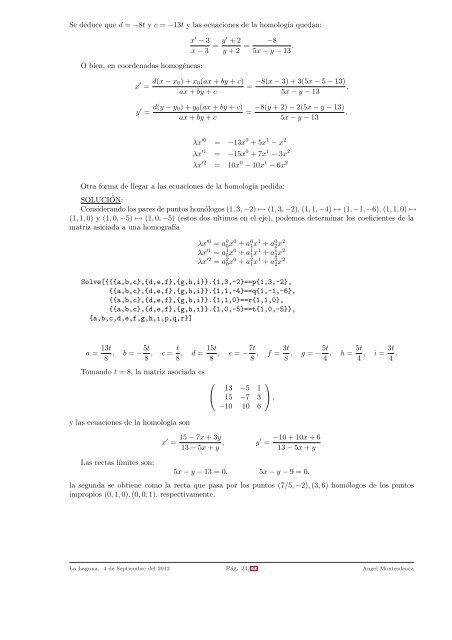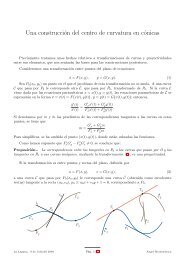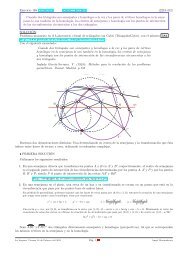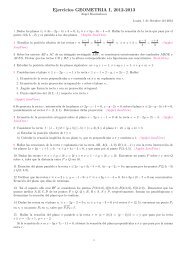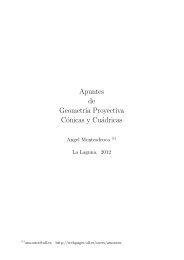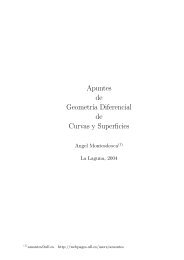homologıa - Geometría
homologıa - Geometría
homologıa - Geometría
You also want an ePaper? Increase the reach of your titles
YUMPU automatically turns print PDFs into web optimized ePapers that Google loves.
Se deduce que d = −8t y c = −13t y las ecuaciones de la homología quedan:<br />
O bien, en coordenadas homogéneas:<br />
x ′ − 3<br />
x − 3 = y′ + 2<br />
y + 2 =<br />
−8<br />
5x − y − 13 .<br />
x ′ = d(x − x0) + x0(ax + by + c)<br />
ax + by + c<br />
y ′ = d(y − y0) + y0(ax + by + c)<br />
ax + by + c<br />
= −8(x − 3) + 3(5x − 5 − 13)<br />
= −8(y + 2) − 2(5x − y − 13)<br />
λx ′0 = −13x 0 + 5x 1 − x 2<br />
λx ′1 = −15x 0 + 7x 1 − 3x 2<br />
λx ′2 = 10x 0 − 10x 1 − 6x 2<br />
Otra forma de llegar a las ecuaciones de la homología pedida:<br />
,<br />
5x − y − 13<br />
.<br />
5x − y − 13<br />
SOLUCI ÓN:<br />
Considerando los pares de puntos homólogos (1, 3, −2) ↦→ (1, 3, −2), (1, 1, −4) ↦→ (1, −1, −6), (1, 1, 0) ↦→<br />
(1, 1, 0) y (1, 0, −5) ↦→ (1, 0, −5) (estos dos ultimos en el eje), podemos determinar los coeficientes de la<br />
matriz asiciada a una homografía<br />
λx ′0 = a 0 0x 0 + a 0 1x 1 + a 0 2x 2<br />
λx ′1 = a 1 0x 0 + a 1 1x 1 + a 1 2x 2<br />
λx ′2 = a 2 0x 0 + a 2 1x 1 + a 2 2x 2<br />
Solve[{{{a,b,c},{d,e,f},{g,h,i}}.{1,3,-2}==p{1,3,-2},<br />
{{a,b,c},{d,e,f},{g,h,i}}.{1,1,-4}==q{1,-1,-6},<br />
{{a,b,c},{d,e,f},{g,h,i}}.{1,1,0}==r{1,1,0},<br />
{{a,b,c},{d,e,f},{g,h,i}}.{1,0,-5}==t{1,0,-5}},<br />
{a,b,c,d,e,f,g,h,i,p,q,r}]<br />
a = 13t<br />
8<br />
, b = −5t<br />
8<br />
, c = t<br />
8<br />
, d = 15t<br />
8<br />
Tomando t = 8, la matriz asociada es<br />
y las ecuaciones de la homología son<br />
Las rectas límites son:<br />
x ′ =<br />
⎛<br />
⎝<br />
, e = −7t<br />
8<br />
13 −5 1<br />
15 −7 3<br />
−10 10 6<br />
, f = 3t<br />
8<br />
⎞<br />
⎠ ,<br />
, g = −5t<br />
4<br />
15 − 7x + 3y<br />
13 − 5x + y , y′ −10 + 10x + 6<br />
=<br />
13 − 5x + y<br />
5x − y − 13 = 0, 5x − y − 9 = 0,<br />
5t 3t<br />
, h = , i =<br />
4 4 .<br />
la segunda se obtiene como la recta que pasa por los puntos (7/5, −2), (3, 6) homólogos de los puntos<br />
impropios (0, 1, 0), (0, 0, 1), respectivamente.<br />
La Laguna, 4 de Septiembre del 2012 Pág. 24/26 Angel Montesdeoca


